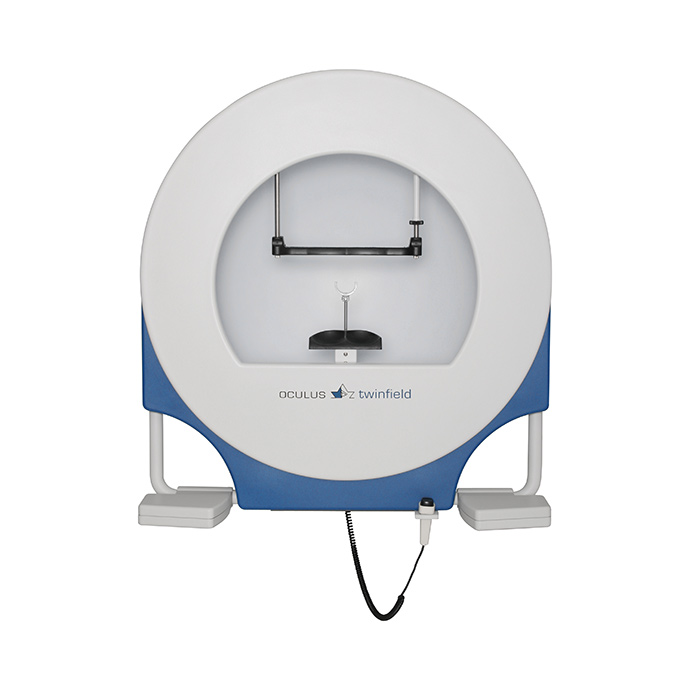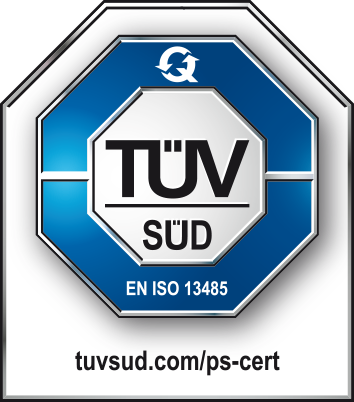Twinfield® 2
The OCULUS Twinfield® 2 provides you with the very best of our more than 50 years of experience in the perimetry area. This device measures the full field of vision using both automatic, static perimetry and automatic or manual kinetic examinations. The Twinfield® 2 received the express recommendation of the German Ophthalmology Society (DOG) for expert assessment perimetry.

Functions
The Examination Programs
The pre-defined test programs of the Twinfield® 2 perimeter have been set up in such a way that you can easily perform the examinations that you require most often. Whether glaucoma, age-related macular degeneration, neurological diseases – appropriate examinations are available for them all. Furthermore, the modular setup of these programs enable you to create custom test processes, as all available test point grids can be conveniently combined with all OCULUS test strategies. You can thus extend the comprehensive standard program series to meet your own particular requirements.
The OCULUS Test Strategies
To gain as much information in the shortest possible time – this principle has always been heeded in the development of all OCULUS test strategies. The SPARK Strategy incorporates data from more than 90 000 diagnoses in a matter of minutes to give precise and stable measurements, especially in Glaucoma detection, diagnosis and progression analysis. The OCULUS Fast Threshold achieves a similar performance with clever improvements to the classic 4-2 step method. And since exact numeric values of the perception threshold do not, in many cases, show any priority, the multiple suprathreshold strategies available in the Twinfield® 2 perimeters offers a faster and more comfortable alternative.
The OCULUS Test Point Grid
Optimally selected examination areas significantly contribute to meaningful visual field findings. The Twinfield® 2 perimeter provides comprehensive, pre-defined test point grids, which cover all areas ranging from the macula area to the entire field of vision. Grids with a higher density of test points in the center, which take account of the physiology of the retina, are the trademark of the Twinfield® 2. Grids with uniform, orthogonally distributed test points along with other grids, such as the Esterman grid, complete the list of available examination areas.
Results Printout
The measuring results of the Twinfield® 2 perimeter are summarized in the standardized results printout. For threshold-determining examinations, all clinically relevant data are recorded and are shown in various different depictions whereas for suprathreshold tests, only a single informational overview is printed.
Static Perimetry
The Twinfield® 2 performs fast and versatile automatic static examinations to measure the central field of vision with a high degree of accuracy. In the macular area, the precision is increased even more by a considerable densification of the test points, and the periphery can be tested using a suitable test grid. The modular setup of the examination programs guarantees that the Twinfield® 2 perimeter can be adapted to meet all clinical research and daily practice requirements.
Improved Diagnostic Reliability
Additional processes improve the diagnostic reliability of perimetric examinations conducted with the Twinfield® 2 perimeter. Re-examination of areas of concern independent of the test point grid and remote observation of the patient’s eye increase the reliability of the findings; the expert system Glaucoma Staging Program (GSP) provides valuable support in the analysis of the findings.
Kinetic Perimetry
Exact adherence to the Goldmann Standard allows the Twinfield® 2 to be used for assessment perimetry purposes. Automation of the kinetic examinations increases the reproducibility of the test. Fast and comprehensive testing of the entire field of vision testing is achieved by linking the fully automatic kinetic tests with static testing methods.
Perimetry-Software
SPARK threshold strategy
Glaucoma Staging Program (GSP)
Threshold Noiseless Trend (TNT) Progression Analysis
- SPARK Precision (optional software) is the full version of SPARK. The complete visual field examination of glaucoma patients takes only 3 minutes per eye. The greater stability of the results allows for more sensitive progression analysis.
- SPARK Quick is used for follow-up or screening examinations. The test takes just 90 seconds per eye.
- SPARK Training is ideal for patient training. The 40 second measurement can also be used as a screening examination.
The GSP software places examination findings into visual field classes (normal, glaucomatous, artifactual and neuro) based solely on their appearance. In addition, risk classes (normal, suspect, pre-perimetric, early stage, moderate and severe) are also assigned to findings that are classified as normal or glaucomatous. The evaluation results are presented in intuitive green-yellow-red color coding.
The striking novelty of the GSP is its ability to detect subtle changes in the visual field associated with early stage glaucoma. Findings of suspect and pre-perimetric risk classes may contain reductions in the visual field that cannot be readily seen by the examiner. They usually remain undetected also by standard perimetric indices.
The Glaucoma Likelihood Index (GLI) summarizes the results of the GSP classification into a single parameter presenting a value between 0 (normal) and 5 (severe glaucoma).
The Glaucoma Staging Program (GSP) is available for OCULUS Twinfield® 2, Centerfield® 2 and Easyfield® perimeters. This upgrade is available for the existing units.
- TNT creates a concise progression analysis report containing the most important parameters (MD increase, p-values, etc.).
- TNT can differentiate between diffuse and focal progression based on the focality index (FI) value.
- TNT applies multiple statistical criteria to establish possible progression.
- TNT displays the prognosis of the expected visual field for a patient age-group selected by the examiner.




Title
Description
FAQ
Technical Data
| Programs | Pre-defined glaucoma, macula, neurological and screening tests; Static-kinetic screening; user-defined tests |
| Strategies | Threshold strategies: OCULUS Fast Threshold, Full Threshold, CLIP Optional: SPARK strategy Age-adapted supra-threshold screening (2-zone, 3-zone, quantify defect, OCULUS Class strategy) |
| Test patterns | Rectangular patterns (30-2, 30-2 bs, 24-2, 24-2 bs, 10-2), Physiological patterns (Area 1-8), Quick Screening, Esterman, customized patterns |
| Stimulus sizes | Goldmann I, III, V |
| Stimulus color | White / Blue / Red |
| Stimulus luminance range / steps | 0 – 318 cd/m² (0 – 1 000 asb) / 0.1 log units |
| Background luminance | 10 cd/m² (31.4 asb) |
| Background color | White / Yellow |
| Stimulus duration | 200 ms / User-defined |
| Examination speed | Adaptive / Slow / Normal / Fast / User-defined |
| Maximum eccentricity | 90° (full field) |
| Fixation control | Video camera image, through central threshold, Heijl-Krakau (using the blind spot) |
| Patient positioning | Motorised double chinrest, height- and depth-adjustable headrest, ergonomic armrest |
| Reports | Glaucoma Staging Program (GSP) Threshold Noiseless Trend (TNT) progression report |
| Strategies | Automatic isopters measured along meridians with freely selectable density Manual: stimulus freely movable with the computer mouse Semi-automatic: including scotoma boundary mapping |
| Stimulus speed | 2°/s (Goldmann), user-defined |
| Bowl radius | r = 11.8 in |
| Dimensions (W x D x H) | 31.1 x 28.5 x 33.5 in |
| Weight | 88.1 lbs – without table |
| Voltage | 90 – 264 V AC |
| Frequency | 50 – 60 Hz |
| Minimal computer requirements | Operating system: Windows® XP or higher |
| Interface | USB |
Contact us!
Request a quote or contact us if you need further information.
Request a quoteContact requestHotline
Questions?
Get in touch with us.
Tel. +1 888 284-8004
